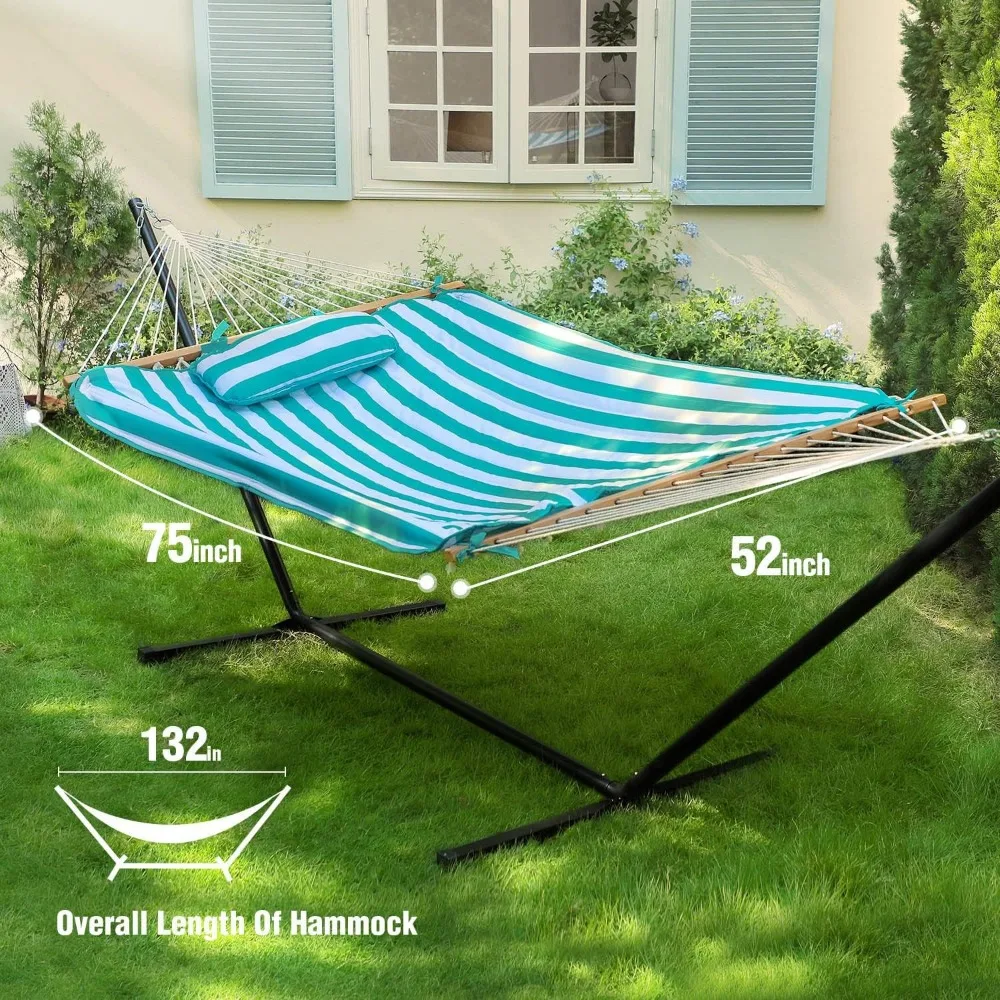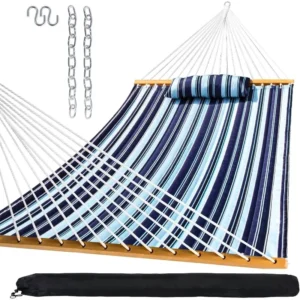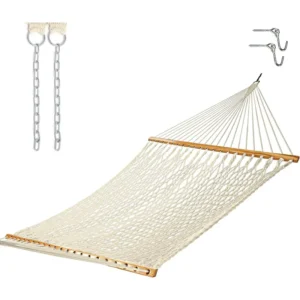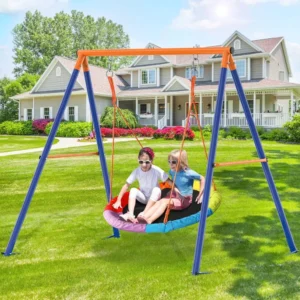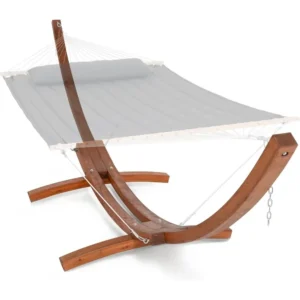Introduction
Hammocks represent the ultimate symbol of relaxation – a gentle swing suspended in air that cradles your body in pure comfort. Whether you’re looking to create a backyard retreat, enhance your camping experience, or add a cozy nook inside your home, hammocks offer an unparalleled way to unwind. However, one crucial decision faces every hammock shopper: cotton or polyester?
The material of your hammock significantly impacts your relaxation experience in several key ways:
– How comfortable it feels against your skin
– How long it will last through seasons of use
– The maintenance it requires to stay in prime condition
– How it performs in different weather conditions
This comprehensive guide aims to settle the cotton versus polyester debate by examining these materials across all important factors. By understanding the unique properties of each, you’ll be able to make an informed decision based on your specific needs, whether you’re planning to use your hammock indoors or outdoors throughout the year.
Understanding Hammock Materials: The Basics of Cotton and Polyester
Cotton Hammocks
Cotton hammocks represent the traditional choice, crafted from natural fibers harvested from cotton plants. These natural fibers are spun into yarn, then woven into the characteristic hammock fabric or rope pattern. Cotton has been used for hammocks for centuries, particularly in South and Central America where the hammock originated.
The natural fiber construction gives cotton hammocks a distinctive soft, textured appearance with a slightly uneven, artisanal quality that many find aesthetically pleasing. To the touch, cotton feels soft, warm, and organic.
Polyester Hammocks
Polyester hammocks, by contrast, are made from synthetic fibers derived from petroleum-based chemicals. This modern material was developed specifically to overcome some of the limitations of natural fibers. The manufacturing process involves chemical reactions that create long polymer chains, which are then extruded into fibers, spun into yarn, and woven into fabric.
Polyester hammocks typically have a more uniform, smoother appearance with consistent coloring and texture. They feel slicker to the touch, with less natural give but more structural stability.
In terms of market positioning, cotton hammocks often appeal to traditionalists and those seeking natural materials, while polyester options tend to target practical, weather-conscious users. Price points vary widely for both materials, though high-quality cotton hammocks generally start at a higher price point than their polyester counterparts.
Both cotton and polyester can be used in various hammock styles, including traditional rope hammocks with different construction techniques that impact their overall feel and performance.
Comfort Factor: Feeling the Difference
When it comes to immediate comfort, cotton and polyester offer distinctly different experiences:
Cotton Comfort Profile:
- Softness: Cotton offers superior initial softness that many find more pleasant against bare skin
- Conformity: Natural fibers relax and stretch over time, molding to your body contours
- Breathability: Excellent air circulation prevents the “sticky” feeling in hot weather
- Temperature regulation: Absorbs moisture and provides warming properties in cool weather
- Break-in factor: Gets increasingly softer and more comfortable with use
Polyester Comfort Profile:
- Softness: Initially stiffer but still reasonably comfortable; never reaches cotton’s natural softness
- Conformity: Maintains its shape with minimal stretching; provides more structured support
- Breathability: Less breathable but wicks moisture away from skin
- Temperature regulation: Stays cooler to the touch but can feel “sweaty” during extended use in heat
- Break-in factor: Maintains consistent feel throughout its life with minimal softening
The right choice depends greatly on your sensitivity to texture and your primary use case. Those who prioritize a natural, soft feel against their skin typically prefer cotton, while those seeking consistent support might lean toward polyester.
For those who want to dive deeper into comfort considerations, learning about the most comfortable hammock type can help you understand how material choice combines with design to create the ultimate relaxation experience.
When sharing your hammock with a partner, material comfort becomes even more important. Outside Luxe offers numerous double hammock sets for two-person relaxation in both cotton and polyester materials.
Durability Comparison: Standing the Test of Time
When investing in a quality hammock, longevity becomes a crucial factor. Cotton and polyester demonstrate significant differences in their durability profiles:
| Durability Factor | Cotton | Polyester |
|---|---|---|
| Tensile Strength | Moderate (weakens when wet) | High (maintains strength in all conditions) |
| Tear Resistance | Good when dry, poor when wet | Excellent in all conditions |
| UV Resistance | Poor (breaks down with sun exposure) | Excellent (resistant to UV degradation) |
| Expected Lifespan | 2-5 years with regular use | 5-10+ years with similar use |
| Common Failure Points | Seams and areas exposed to moisture | Connection points and high-friction areas |
Cotton hammocks begin to show wear more quickly, with fibers breaking down from environmental exposure. The material tends to thin out in high-pressure areas like the center and attachment points. Typically, a well-maintained cotton hammock will provide 2-5 years of regular service before needing replacement.
Polyester hammocks demonstrate remarkable resilience to environmental stressors. The synthetic fibers resist breaking down from UV exposure, maintain strength when wet, and generally withstand physical stress better than natural fibers. With proper care, a quality polyester hammock can last 5-10 years or more.
For those prioritizing long-term durability, Outside Luxe offers several heavy-duty hammock sets designed specifically for extended use and maximum longevity.
Weather Resistance: The Outdoor Performance Test
Weather resistance represents perhaps the starkest contrast between these two hammock materials:
Water Resistance and Drying
Cotton is highly absorbent, capable of soaking up to 27 times its weight in water. This creates several challenges:
– Becomes extremely heavy when wet
– Takes 24+ hours to fully dry in average conditions
– Can develop mildew and unpleasant odors if stored damp
– Weakens significantly when saturated
Polyester repels water rather than absorbing it, resulting in:
– Minimal weight increase when exposed to rain
– Quick drying time of just 1-3 hours
– Resistance to mildew and mold growth
– Maintains structural strength when wet
UV and Sun Exposure
Cotton fibers break down relatively quickly under UV exposure, causing:
– Fading colors within one season
– Weakening fibers that lead to tears and splits
– Reduced lifespan for hammocks in sunny locations
Polyester offers superior UV resistance:
– Colors remain vibrant for multiple seasons
– Material integrity maintained under sun exposure
– Significantly longer lifespan in sunny environments
Temperature and Climate Performance
Cotton performs best in:
– Dry, moderate climates
– Covered areas protected from direct weather
– Seasonal use with indoor storage during off-seasons
Polyester excels in:
– Varied and unpredictable climates
– Direct outdoor exposure
– Year-round use with minimal storage requirements
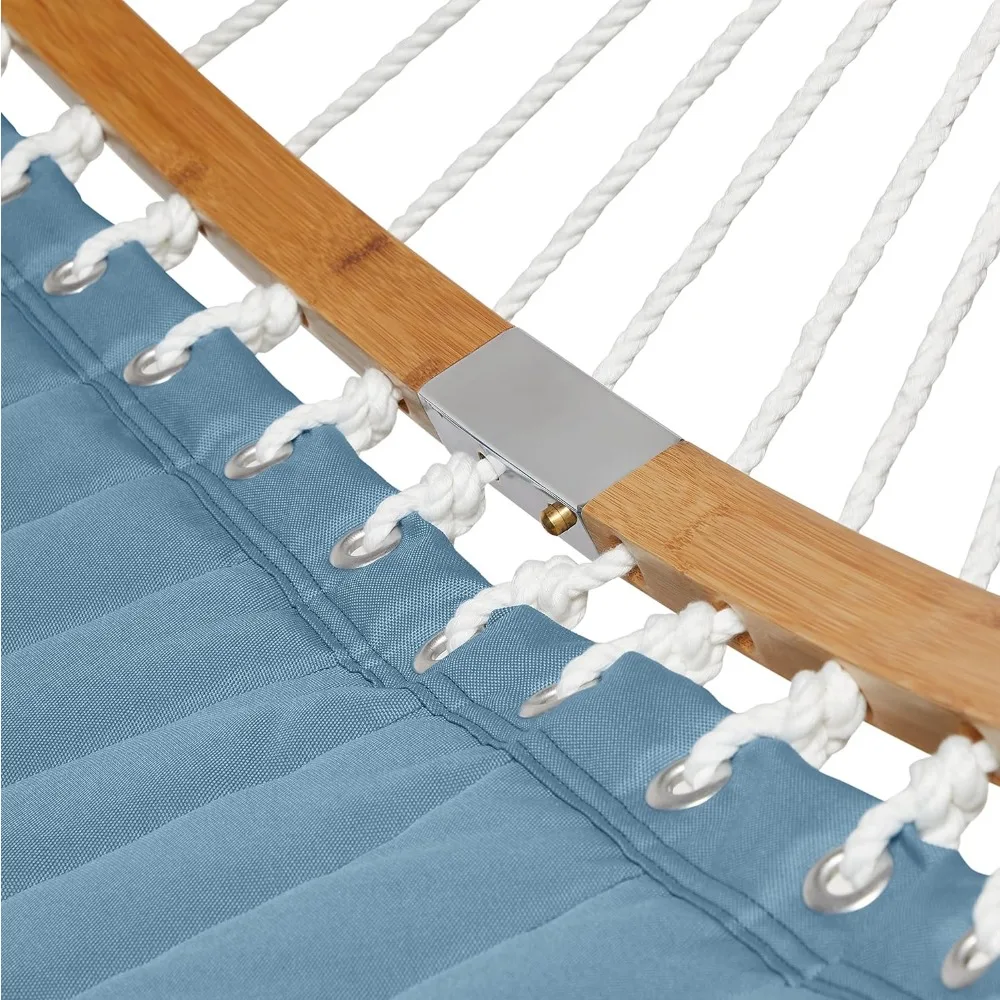
For those concerned about weather protection, exploring waterproof materials for hammock protection and understanding whether it’s okay to leave your hammock outside can provide additional guidance for your specific situation.
Maintenance Requirements: Keeping Your Hammock in Prime Condition
The maintenance differences between cotton and polyester hammocks directly impact the overall ownership experience:
Cotton Hammock Maintenance
- Cleaning Frequency: Requires cleaning every 2-3 months with active use
- Cleaning Method: Hand wash with mild soap, rinse thoroughly, air dry completely
- Storage Requirements: Must be completely dry before storage; needs breathable storage bag
- Weather Protection: Should be brought indoors during rain and removed for extended periods of harsh weather
- Restoration Options: Can be refreshed with fabric softeners; minor repairs possible but difficult
Polyester Hammock Maintenance
- Cleaning Frequency: Typically needs cleaning only 1-2 times per year
- Cleaning Method: Can be machine washed on gentle cycle or hosed off and air-dried
- Storage Requirements: Can be stored slightly damp if necessary; less susceptible to storage damage
- Weather Protection: Can withstand occasional rain, though extended exposure should be avoided
- Restoration Options: Easily spot-cleaned; more receptive to repairs and patches
For those seeking low-maintenance options, exploring Outside Luxe’s collection of fabric hammock sets can help you find the right balance between comfort and convenience.
Practical Usage Considerations: When and Where to Use Each Material
The ideal material for your hammock depends largely on where and how you’ll use it:
Cotton Hammocks Excel In:
- Indoor settings where weather isn’t a factor
- Covered porches and patios with overhead protection
- Dry climates with minimal humidity
- Situations where maximum comfort is the top priority
- Short-term seasonal use with proper storage in off-seasons
Polyester Hammocks Excel In:
- Outdoor settings with exposure to elements
- Humid environments where moisture resistance matters
- Camping and travel scenarios requiring durability
- Situations requiring minimal maintenance
- Year-round installation with limited protection
When evaluating your specific scenario, consider factors like local climate, available protection, frequency of use, and whether you’re willing to bring your hammock in during inclement weather.
For deeper insights into material selection based on environment, our guide on the best material for outdoor hammocks offers additional considerations to help with your decision.
Weight and Portability: On the Move with Your Hammock
For those who plan to transport their hammock frequently, weight and portability become crucial considerations:
Cotton Hammocks:
- Average Weight: 4-7 pounds for a standard single hammock
- Packed Size: Bulkier with limited compression
- When Wet: Can more than double in weight when saturated
- Travel Suitability: Better for fixed installations than frequent moving
- Stand Requirements: Often require sturdier, heavier stands due to material weight
Polyester Hammocks:
- Average Weight: 1-3 pounds for comparable size
- Packed Size: More compressible with smaller packed footprint
- When Wet: Minimal weight increase when exposed to moisture
- Travel Suitability: Excellent for camping, travel, and frequent relocation
- Stand Requirements: Compatible with lightweight portable stands
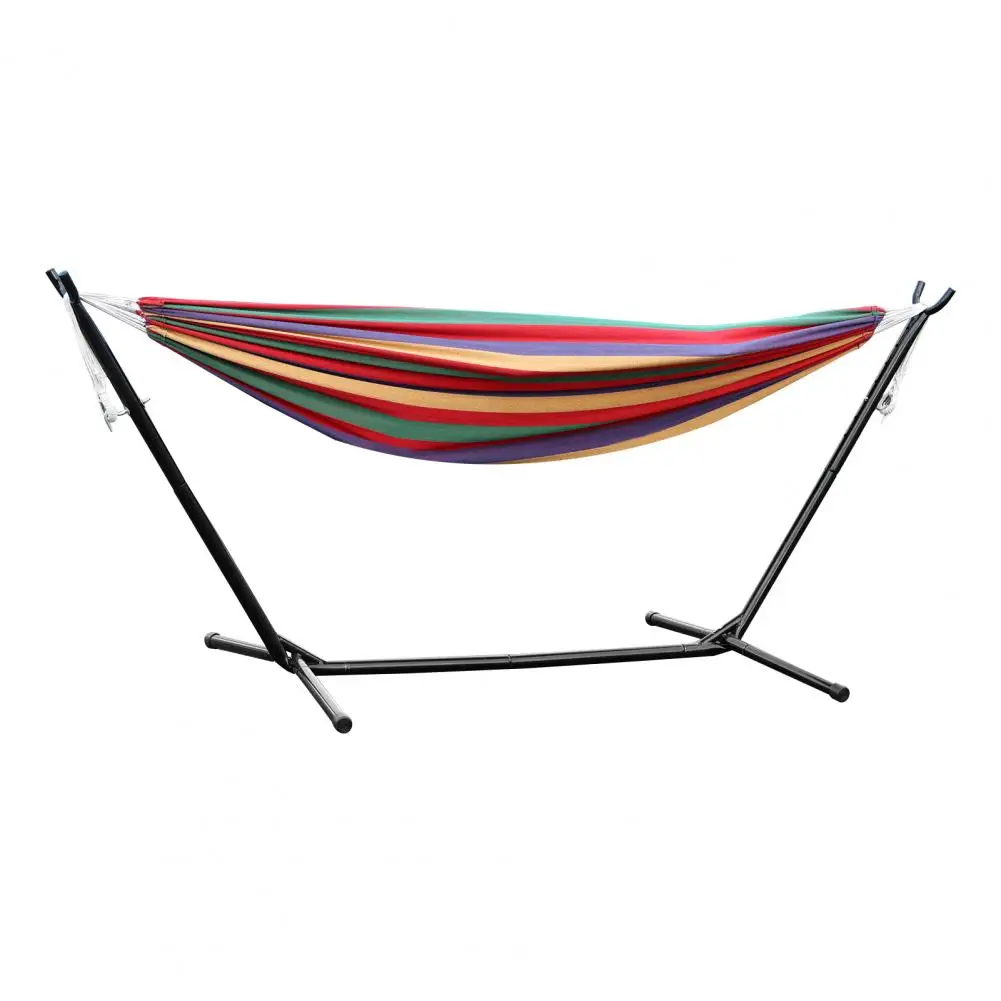
For avid travelers and campers, understanding camping hammock weights can help you make more informed decisions about the right material for your mobile lifestyle.
Outside Luxe offers several portable hammocks with stands designed specifically for those who value mobility and convenience without sacrificing comfort.
Cost and Value Analysis: Investment vs. Return
Initial price is just one component of the total cost of ownership. Here’s how cotton and polyester hammocks compare financially:
Initial Purchase Price:
- Cotton Hammocks: $70-$300+ for quality options
- Polyester Hammocks: $50-$250+ for comparable quality
Long-Term Value Factors:
- Lifespan: Cotton typically lasts 2-5 years versus polyester’s 5-10+ years
- Maintenance Costs: Cotton may require special cleaning products and more frequent replacement
- Annual Cost: When divided by years of service, polyester often represents better long-term value
- Replacement Frequency: Cotton hammocks may need replacement 2-3 times during a polyester hammock’s lifetime
When evaluating value, consider not just the upfront cost but how long you expect the hammock to serve your needs. Those planning long-term use often find the additional durability of polyester justifies any price premium, while those seeking the premium comfort of cotton may be willing to replace more frequently.
Classic Wooden Stand Hammock Sets, Heavy Duty Hammock Sets
$1,061.68 Select options This product has multiple variants. The options may be chosen on the product pageHammock Sets with Canopy, Heavy Duty Hammock Sets
$286.31 Select options This product has multiple variants. The options may be chosen on the product pageDouble / Two Person Hammock Sets, Rope Hammock Sets
Double Traditional Cotton Rope Hammock with Extension Chains – 450 lbs Capacity for Backyard & Patio$292.98 Select options This product has multiple variants. The options may be chosen on the product pageFolding Hammock Sets, Quick Setup Hammock Sets
Price range: $305.52 through $583.27 Select options This product has multiple variants. The options may be chosen on the product pageHeavy Duty Hammock Sets, Wooden Arc Stand Hammock Sets
$878.66 Select options This product has multiple variants. The options may be chosen on the product page
For those interested in traditional styles in both materials, explore Outside Luxe’s collection of rope hammock sets offering both cotton and polyester options at various price points.
Environmental Considerations: Making an Eco-Friendly Choice
Environmental impact has become an increasingly important factor for many consumers:
Cotton Environmental Profile:
- Raw Material: Renewable natural resource, but conventional cotton farming uses significant water and pesticides
- Manufacturing Impact: Generally lower energy requirements for processing
- Biodegradability: Naturally biodegrades at end of life
- Eco-Friendly Options: Organic cotton options available with reduced environmental impact
- Carbon Footprint: Mixed impact – renewable source but resource-intensive cultivation
Polyester Environmental Profile:
- Raw Material: Petroleum-based, non-renewable resource
- Manufacturing Impact: Energy-intensive production process
- Biodegradability: Not biodegradable, remains in environment for hundreds of years
- Eco-Friendly Options: Recycled polyester options becoming more available
- Carbon Footprint: Higher manufacturing footprint but longer lifespan means fewer replacements
For environmentally conscious consumers, the ideal choice may depend on your specific priorities – natural materials versus product longevity. Organic cotton and recycled polyester represent the most eco-friendly options within each category.
Creating a perfect hammock haven involves considering not just your comfort but also your environmental values and how your choices impact the planet.
The Verdict: Which Hammock Material is Right for You?
After examining all factors, the “better” material truly depends on your specific needs and priorities:
Choose Cotton If:
- Maximum comfort against skin is your top priority
- You’ll use the hammock primarily indoors or in protected areas
- You don’t mind more frequent maintenance
- You prefer natural materials with traditional aesthetics
- You’re willing to replace more frequently for premium comfort
Choose Polyester If:
- Weather resistance and durability are critical factors
- You plan to leave your hammock outdoors frequently
- Low maintenance is important to you
- You need portability for camping or travel
- You want the best long-term value and longevity
Many hammock enthusiasts actually end up owning both types – cotton for protected areas where comfort is paramount, and polyester for outdoor locations where durability matters most.
For more guidance on selecting the right hammock for your specific environment, our guide on indoor vs. outdoor hammock selection provides additional detailed considerations.
Cotton Hammock Pros and Cons: A Comprehensive List
Cotton Hammock Pros:
- Superior Natural Comfort: Unmatched softness and feel against bare skin
- Excellent Breathability: Prevents overheating and stickiness in warm weather
- Natural Material: Renewable resource with biodegradable end-of-life
- Traditional Aesthetic: Classic look with natural texture and authentic character
- Improves with Age: Becomes softer and more comfortable with use
- Temperature Adaptability: Warm in cool weather, breathable in warm conditions
Cotton Hammock Cons:
- Poor Weather Resistance: Absorbs water readily and takes days to dry completely
- UV Vulnerability: Breaks down quickly with sun exposure
- Higher Maintenance: Requires regular cleaning and careful storage
- Shorter Lifespan: Typically lasts only 2-5 years with regular use
- Mold Susceptibility: Can develop mildew and odors if stored damp
- Weight When Wet: Becomes extremely heavy when saturated with water
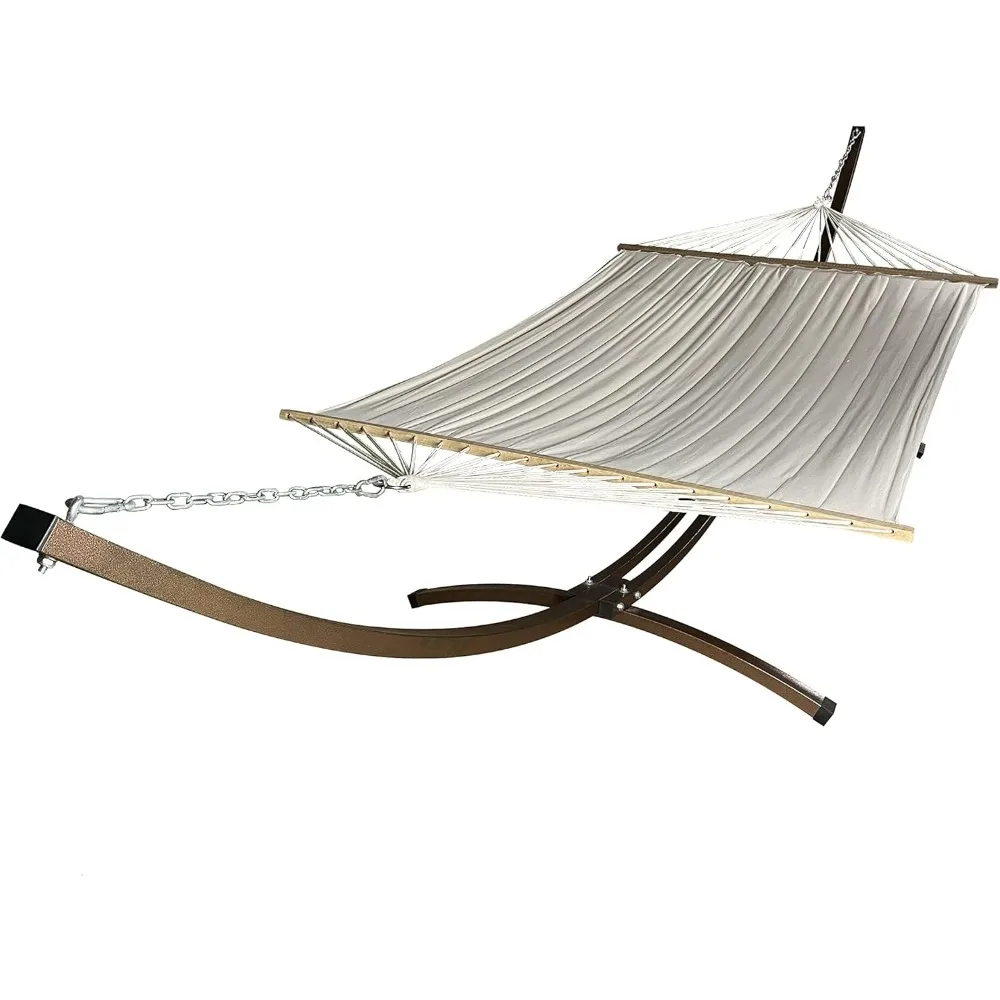
For those who appreciate the premium comfort of cotton with added durability features, Outside Luxe offers quilted fabric hammock sets that provide enhanced structure and longevity.
Polyester Hammock Pros and Cons: What You Need to Know
Polyester Hammock Pros:
- Exceptional Durability: Lasts 5-10+ years with proper care
- Weather Resistance: Repels water and dries quickly
- UV Stability: Resists sun damage and color fading
- Low Maintenance: Requires minimal cleaning and care
- Consistent Performance: Maintains properties throughout its lifespan
- Lightweight: Easier to transport and reposition
- Value: Better long-term cost efficiency due to longevity
Polyester Hammock Cons:
- Less Natural Feel: Synthetic texture lacks the organic softness of cotton
- Heat Retention: Can feel hot or “sweaty” during extended use in warm weather
- Environmental Concerns: Petroleum-based material that doesn’t biodegrade
- Less Breathable: Doesn’t allow as much airflow as cotton
- Static Electricity: Can develop static in dry conditions
- Limited “Give”: Doesn’t conform to body contours as naturally as cotton
Regardless of which material you choose, proper hammock installation and safety considerations remain essential to ensure your relaxation is both comfortable and secure.
Is There a Perfect Middle Ground? Blended Materials and Alternatives
For those seeking the benefits of both worlds, several alternatives exist:
Cotton-Polyester Blends:
These hammocks combine natural and synthetic fibers to balance comfort and durability. Typically containing 40-60% cotton with the remainder polyester, they offer:
– Improved softness compared to pure polyester
– Better weather resistance than pure cotton
– Moderate maintenance requirements
– Intermediate price points
– Lifespan of 3-7 years depending on blend ratio
Alternative Materials:
Several other options have entered the market:
– Nylon: Extremely lightweight and portable, popular for camping hammocks
– Sunbrella: Acrylic fabric with exceptional weather resistance and comfort
– DuraCord: Proprietary synthetic rope with cotton-like feel but polyester durability
– Textilene: Mesh-like synthetic with excellent breathability and durability
Different fabric types for quilted hammocks offer varying combinations of comfort, durability, and weather resistance that might provide the perfect balance for your specific needs.
How to Extend the Life of Your Hammock Regardless of Material
Regardless of which material you choose, these universal care tips will help maximize your hammock’s lifespan:
- Proper Storage: Always store indoor when not in use for extended periods
- Sun Protection: Use hammock canopies or place in shade to reduce UV exposure
- Weight Distribution: Spread weight evenly and stay within recommended capacity
- Proper Hanging: Maintain correct tension to avoid stress on fibers
- Cleaning Schedule: Remove dirt, salt, and body oils before they damage fibers
- Address Damage Promptly: Repair small tears or weakened areas before they spread
- Weather Awareness: Bring hammocks in during severe weather regardless of material
- Rotation: Change orientation periodically to ensure even wear
For maximum protection in outdoor settings, consider hammock sets with protective canopies that shield your hammock from both UV rays and moisture, extending its useful life.
Frequently Asked Questions About Cotton and Polyester Hammocks
Q: Can cotton hammocks be used outdoors at all?
A: Yes, cotton hammocks can be used outdoors in covered areas or when you can bring them in during inclement weather. They’re best for fair-weather use with proper storage during rain or extended sun exposure.
Q: How do I clean a polyester hammock without damaging it?
A: Most polyester hammocks can be machine washed on gentle cycle with mild detergent, then air-dried. Always check manufacturer instructions, as some may have specific care requirements.
Q: Which material is safer for children?
A: Both materials are safe for children when properly installed. Polyester may have a slight advantage in maintaining structural integrity over time, but proper installation and weight limits are more important safety factors than material choice.
Q: Do cotton hammocks stretch more than polyester?
A: Yes, cotton naturally stretches more with use. This can create a deeper, more enveloping cradle effect, but may require occasional tension adjustment. Polyester maintains its original dimensions better over time.
Q: Can either material type support two adults?
A: Both materials can support two adults when designed as double hammocks and properly installed. Always check the specific weight capacity of any hammock before use, as construction methods and design impact capacity more than material alone.
Q: How do I prevent mold on my cotton hammock?
A: Always ensure your cotton hammock is completely dry before storage, store in a breathable bag (not plastic), and place in a dry location. Consider using a mild fabric protectant designed for outdoor textiles.

